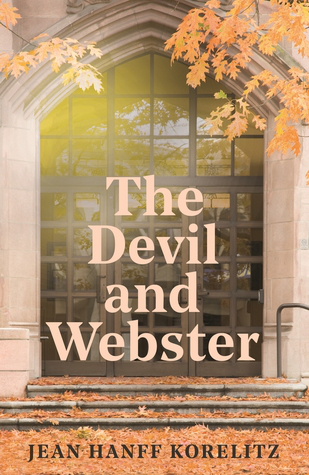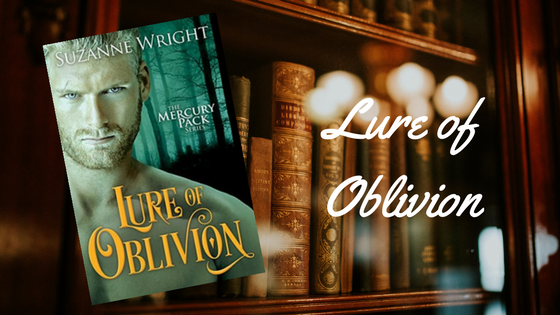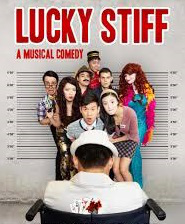It’s hard to resist a campus novel. The Devil and Webster, the sixth novel by Jean Hanff Korelitz, is unusual in focusing more on the administration than the students of a fictional American college. Webster College, Massachusetts was founded as a Native American training academy in the eighteenth century by missionary Josiah Webster. Now it rivals Harvard and other Ivy League schools, attracting liberal students with its enlightened gender and racial politics. (I had Swarthmore and Oberlin in mind as models.)
Yet Naomi Roth, Webster’s first female president, soon finds that racial and sexual tension still bubble under the surface here. A decade ago, her first major challenge as president was dealing with the uproar when Nell Jones-Givens, who lived in female-only Radclyffe Hall, began transitioning to become Neil. But now she faces an even stickier problem: A group of students have set up an Occupy-style camp in the center of the quad to protest the decision to deny tenure to Nicholas Gall, a popular African-American anthropology professor.
 The protest is spearheaded by Omar Khayal, a charismatic Palestinian refugee who wowed Naomi’s closest friend, Dean of Admissions Francine Rigor, with his application essay about growing up in the midst of conflict and surviving the death of his entire family. What Omar and these other outraged students don’t know – and Naomi can’t reveal because of the confidentiality of the process – is that Gall has a negligible publication record and was also found guilty of plagiarism. They instead presume that this is all because he is black.
The protest is spearheaded by Omar Khayal, a charismatic Palestinian refugee who wowed Naomi’s closest friend, Dean of Admissions Francine Rigor, with his application essay about growing up in the midst of conflict and surviving the death of his entire family. What Omar and these other outraged students don’t know – and Naomi can’t reveal because of the confidentiality of the process – is that Gall has a negligible publication record and was also found guilty of plagiarism. They instead presume that this is all because he is black.
What starts off as manageable dissent thus morphs into unpleasant, racially motivated retribution. “Webster is not a city on a hill. Webster is still the reactionary place it was before,” Omar declares in a media interview. In this context, Naomi’s upcoming Native American conference, though planned long ago, seems like a pathetic attempt at placation.
Throughout, the third-person narration sticks close to Naomi, a compelling protagonist not least because she’s a single mother and her daughter Hannah is also a protesting Webster student. By documenting Naomi’s thoughts (often in italics) versus what she says, Korelitz emphasizes the difficult position she’s in, always having to hold her tongue and speak diplomatically, as when addressing the protest camp:
“My only interest is in learning more about your concerns and your intentions. We share this community, and I’m sure we all want the best for it. If there are problems to be identified, issues to be discussed, changes to be made…whatever. It won’t happen if you won’t…” Talk, she wanted to say. Open your fucking mouths with their years of orthodontia and use those expensively educated voices to articulate your pathetic complaints about this…this halcyon, evolved, rarified, creative, and intellectual college campus, where you are free to learn and nap and make things and have sex and get high and change your fucking gender even, and clean water comes out of the tap and you wave your school ID under a scanner to help yourself to smorgasbords of food (meat! meat alternative! vegan! lactose-sensitive! nut-free! gluten-free!) and all we expect of you is that you pass your classes and don’t hurt anyone else. But she didn’t say these things. Of course she didn’t say them.
Naomi has her own background in feminist activism, but now, instead of being in a position to ‘speak truth to power,’ she has to realize that, as Francine reminds her, she is the power.
This is an interesting book about appearances and assumptions. Again and again characters make ethical compromises, proving how difficult it is to find and maintain the moral high ground. As the college’s historian points out to Naomi, from its very beginnings Webster has had a tendency towards capitulation. He plans to write up this story in a book called The Devil and Webster – which is also a reference to “The Devil and Daniel Webster,” the 1936 O. Henry Award-winning, Faustian short story by Steven Vincent Benét. I haven’t read the story, but looking at a synopsis I can see that it’s relevant in that it touches on themes of race, patriotism and the treatment of Native Americans.
The story line feels fresh and surprising, if at times melodramatic. My problem was more with the author’s style, which seemed to me old-fashioned and belabored. Korelitz has a habit of minutely describing everything: a house, a room, the food, the hairstyles, and so on. There are four pages on Naomi’s presidential wardrobe, and we get not just a passing reference to her PhD thesis but three pages on it. This means that it feels like it takes forever for the plot to get going. Much of modern fiction is more minimalist, I think, or would more naturally weave in its short bits of backstory. I even wondered if this book would have been better off as a collection of linked short stories from different points in Naomi’s or the college’s past.
This is all a shame, because while I liked the characters, dialogue and setting and enjoyed many of the turns of phrase (e.g. “filling in the spousal synapses” and “Garrison Keillor’s voice had a narcotic vocal element that always made her feel sleepy, each word a nepenthe puff”), I found the book tiresome overall, and can’t imagine myself picking up another one from Korelitz any time soon.
The Devil and Webster was published in the UK by Faber & Faber on April 6th and in the USA by Grand Central Publishing on March 21st. My thanks to Josh Smith for the review copy.
My rating: 
Besides Donna Tartt’s The Secret History, I’ve loved Kingsley Amis’s Lucky Jim, Chad Harbach’s The Art of Fielding, Julie Schumacher’s Dear Committee Members, and many of David Lodge’s books. See also my review of Bradstreet Gate by Robin Kirman.
Advertisements Share this:- Fiction Reviews





